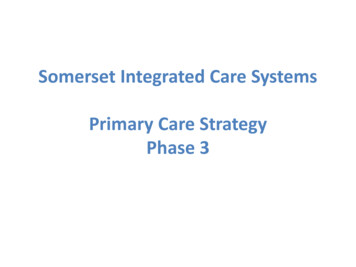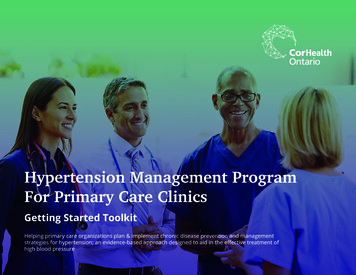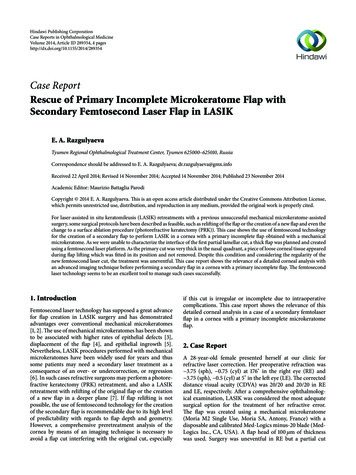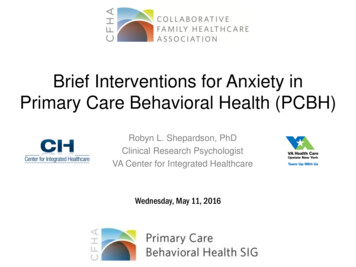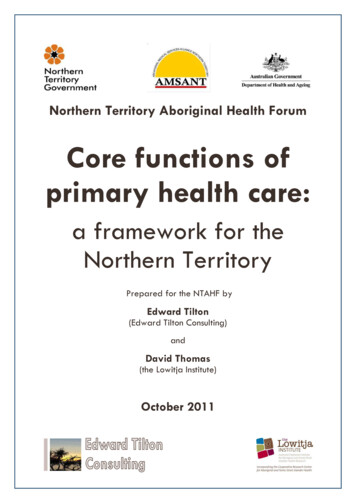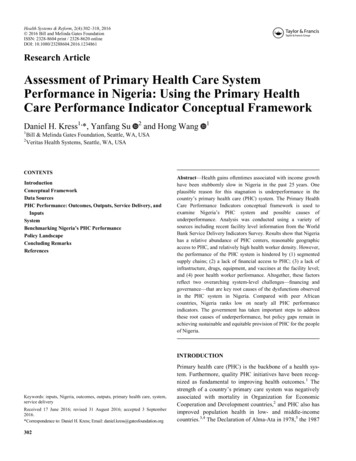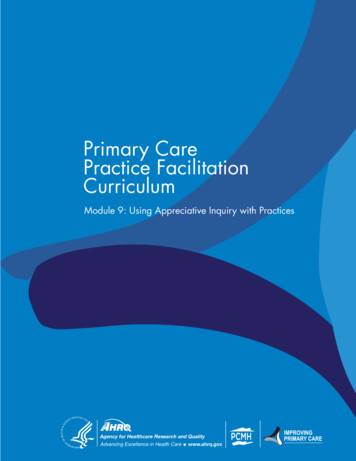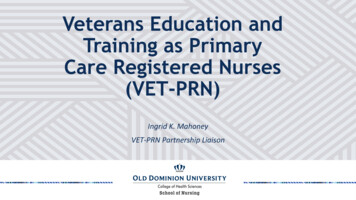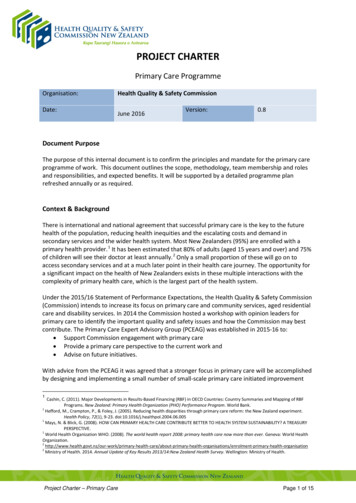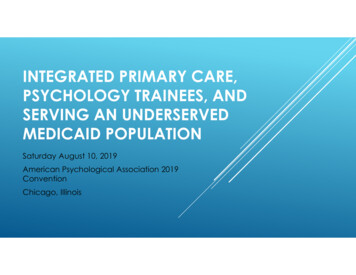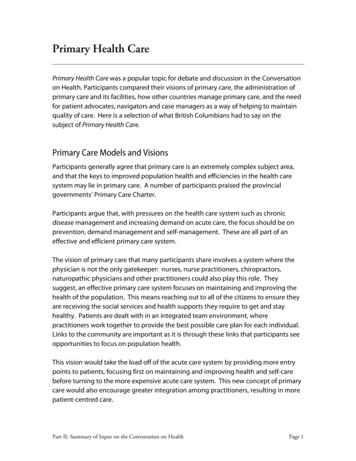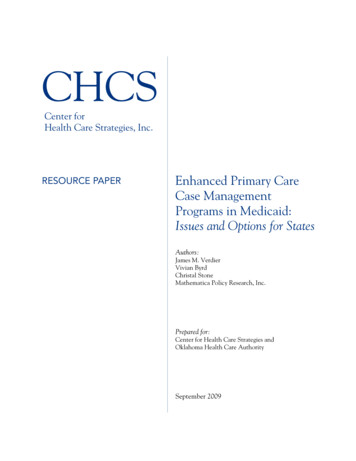
Transcription
CHCSCenter forHealth Care Strategies, Inc.RESOURCE PAPEREnhanced Primary CareCase ManagementPrograms in Medicaid:Issues and Options for StatesAuthors:James M. VerdierVivian ByrdChristal StoneMathematica Policy Research, Inc.Prepared for:Center for Health Care Strategies andOklahoma Health Care AuthoritySeptember 2009
Enhanced Primary Care Case Management Programs in Medicaid: Issues and Options for StatesAcknowledgmentsWe are grateful to all of those we interviewed in the five states included in our report for their insightsand for all of the information and documents they provided. We are especially grateful to theleadership and staff of the Oklahoma Health Care Authority for their support of this project, and to theCenter for Health Care Strategies (CHCS) for their support. Melanie Bella of CHCS provided detailedcomments and suggestions on drafts of the report. Karen LLanos, Alice Lind, and Lorie Martin of CHCS alsoprovided helpful comments and suggestions at various stages of the project.Within Mathematica, Mary Harrington, Randall Brown, and Margaret Colby provided careful reviews anddetailed comments and suggestions on drafts of the report.
Enhanced Primary Care Case Management Programs in Medicaid: Issues and Options for StatesTable of ContentsExecutive Summary . iI. Introduction. 1A. Purpose of the Paper . 1B. Methods . 2C. Overview of the Remainder of the Report . 2II. Brief History of the SoonerCare Choice Enhanced PCCM Program. 5A. Origin and Early Years of SoonerCare: 1992-1996 . 5B. Development and Expansion of Managed Care: 1997-2003 . 6C. Enhancing the PCCM Model and Expanding Coverage: 2004-2009 . 7III. Approaches to Care Coordination and Care Management . 8A. Evolution of Care Management and Care Coordination in PCCM Programs . 8B. Some Care Coordination Lessons from Medicare and Their Potential Application to Medicaid . 10C. Oklahoma. 12D. North Carolina. 16E. Pennsylvania . 17F. Indiana . 20G. Arkansas. 23IV. Measuring Costs and Savings for Enhanced PCCM Programs . 25A. Oklahoma . 26B. North Carolina . 27C. Pennsylvania . 28D. Indiana . 28E. Arkansas . 29V. Lessons and Conclusions . 30A. Overview of Program Similarities and Differences . 30B. Care Management and Care Coordination . 30C. Measuring Costs and Savings of PCCM Enhancements . 34D. Implementing PCCM Enhancements . 34E. MCOs or Enhanced PCCMs? . 35F. Concluding Thoughts . 36
Enhanced Primary Care Case Management Programs in Medicaid: Issues and Options for StatesExecutive SummaryState Medicaid programs have been operating primary care case management (PCCM) programs since the1980s. These programs typically have involved linking beneficiaries to primary care providers (PCPs) andpaying the providers about 3 per month per beneficiary for a limited range of care management activities,such as providing authorization for emergency room (ER) and specialist visits. Beginning in the 1990s andincreasingly today, states have been seeking to enhance these basic PCCM programs with additional features,1including more intensive care management and care coordination for high-need beneficiaries, improvedfinancial and other incentives for PCPs, and increased use of performance and quality measures such asHealthcare Effectiveness Data and Information Set (HEDIS), Consumer Assessment of Healthcare Providers2and Systems (CAHPS), provider profiles, and similar measures.Purpose of the PaperThis resource paper examines how five states have developed and implemented enhanced PCCM programs,building on an in-depth evaluation that Mathematica Policy Research, Inc. (MPR) recently completed of3Oklahoma’s enhanced PCCM program (SoonerCare Choice). It also looks at enhanced PCCM programs inNorth Carolina, Pennsylvania, Indiana, and Arkansas.The paper describes and assesses several enhancement options states may want to consider for their PCCMprograms, with a special focus on options that can improve care coordination and care management for4beneficiaries with chronic illnesses and disabilities. All five states include such beneficiaries in their PCCMprograms.The document also explores ways in which enhancements can be paid for by savings that may result fromimproved care coordination or that might be justified by the improvements in the quality of care provided. Itis aimed at states that may not have the option of contracting with fully capitated at-risk managed careorganizations (MCOs), or that want to consider non-MCO options that may be a better fit in particular areasof the state (rural areas, for example), or for certain Medicaid populations, such as those who are chronicallyill or disabled. As the Oklahoma experience shows, having a well developed PCCM program operating inparts of a state can also increase a state’s leverage in dealing with MCOs, and can provide a comparativebenchmark for MCO performance.Approaches to Care Coordination and Care ManagementFew physician offices have the resources needed to fully manage and coordinate patient care, especially forchronically ill and disabled patients with complex care needs. The time, staff, information technologyresources, and knowledge of social and community support systems that are needed are usually not available insmall physician offices. Large group practices may have more of the needed resources, including medicalspecialists, but may not provide the full range of necessary specialty care or have links to non-medicalcommunity resources.To fill these gaps, states have sought to enhance their PCCM programs in various ways to supplement thelimited ability among most primary care providers to provide care management and care coordination.1The terms care management, care coordination, and case management are often used interchangeably. We do so in this paper to capture therange of terms used in different states, not to imply precise differences in meaning.2HEDIS is the Healthcare Effectiveness Data and Information Set, which includes a wide range of quality and access measures. CAHPS is theConsumer Assessment of Healthcare Providers and Systems, a widely used consumer satisfaction survey.3Mathematica Policy Research, Inc. “SoonerCare 1115 Waiver Evaluation: Final Report.” Prepared for the Oklahoma Health Care Authority,January 2009. Available at: http://okhca.org/research.aspx?id 10087&parts 7447. Accessed August 12, 2009.4These beneficiaries are usually in the “disabled” eligibility category in state Medicaid programs, and are often referred to as ABD (aged, blind,and disabled) or SSI (Supplemental Security Income) beneficiaries.i
Enhanced Primary Care Case Management Programs in Medicaid: Issues and Options for StatesMedicaid MCOs are typically expected or required to perform these care management and coordinationfunctions as part of their state contracts and to fund them out of savings they are expected to achieve fromreductions in unnecessary hospitalizations, ER use, and other costly services. It may be possible for states tofund PCCM care coordination enhancements with similar savings from high-cost services or with additionalstate funding, but such savings are not assured, nor is additional funding.Some Care Coordination Lessons from Medicare DemonstrationsRandall Brown of MPR recently summarized the results of MPR’s evaluation of 15 programs in the 2002 to2008 Medicare Coordinated Care Demonstration. He describes six key components that distinguishedsuccessful programs from the ineffective ones: Targeting. Interventions were most likely to be successful for patients who are at substantial risk ofhospitalization in the coming year. In-person contact. While many contacts with patients were by telephone, the most successful programsaveraged nearly one in-person contact per patient per month during the patients’ first year in theprogram, far more than the unsuccessful programs. Close interaction between care coordinators and primary care physicians. Two major factors affectedthe strength of this relationship: the opportunity for some face-to-face interaction, and having a carecoordinator work with all of a given physician’s patients. Access to timely information on hospital and ER admissions. Learning about acute care episodes verysoon after they occur is a critical factor in preventing readmissions. Services provided to patients. All the successful programs focused on helping patients manage their ownhealth care, especially teaching them how to take their medications properly. For patients who neededsocial supports (e.g., help with daily living activities, transportation, overcoming isolation), successfulprograms had staff who could arrange for those services. Staffing. The successful programs relied heavily on registered nurses to deliver the bulk of theirinterventions, with assistance from social workers for some patients.Brown notes that this kind of care coordination can be quite resource-intensive, so more experience andresearch is needed on how to do it most effectively and efficiently. If care coordination must pay for itself outof reductions in hospitalizations, ER use, and other expensive services, there are limits on how extensivecoordination activities can be. In particular, Brown notes, there are challenges in identifying the optimaltarget population, determining whether coordination activities for individual patients should be continuous orepisodic, and establishing what mix of nurse-oriented interventions and social service supports is mosteffective.There are important differences between Medicare and Medicaid populations, however, so some caution iswarranted in extrapolating care coordination lessons from Medicare to Medicaid. Since Medicare-Medicaiddual eligibles are usually excluded from Medicaid PCCM programs, chronically ill and disabled enrollees inthese programs are almost all under age 65, and there is an unusually high level of mental illness in thisMedicaid population. In addition, Medicare beneficiaries generally have higher education and income levels,more family and community supports, more stable housing arrangements, and lower incidence of substanceabuse problems. Interventions that rely on beneficiary education in chronic illness self-management, or thatrequire extensive coordination among patients, primary care physicians, and caregivers, may be less effectivewith patients who have significant cognitive impairments or limited family support.ii
Enhanced Primary Care Case Management Programs in Medicaid: Issues and Options for StatesCare Coordination in the Five StatesThe five states reviewed for this paper have handled care coordination in a variety of ways, some of which areconsistent with these lessons from Medicare, and some not, reflecting limits on state resources and perhapssome of the differences between Medicare and Medicaid beneficiaries.OklahomaThe SoonerCare Choice PCCM program that Oklahoma established in 1996 had some care coordinationenhancements (a nurse advice line and exceptional-needs coordinators for aged, blind, disabled (ABD)enrollees with complex medical conditions), but the major enhancements began in 2004. In that year, theOklahoma Medicaid agency hired 32 nurse care managers and two social services coordinators with newfunding and hiring authority obtained from the legislature following the state’s decision in late 2003 to endthe state’s capitated MCO-based Medicaid managed care program (SoonerCare Plus) and replace it with thePCCM program. The new staff was intended to provide the kind of care coordination that was previouslyprovided in the MCO program, but at a lower cost.In 2006, the legislature authorized a new Health Management Program to provide care coordination for up to5,000 high-cost, high-need enrollees; the program was implemented in early 2008. In addition, in early 2009,the state implemented a “medical home” initiative aimed at strengthening reimbursement-related providerincentives for care coordination and improving the care coordination capabilities of provider practices.Medicaid physician reimbursement in Oklahoma is relatively high (100 percent of Medicare in 2008), whichhelps support provider participation in these programs. Performance monitoring and reporting is wellestablished in the Oklahoma PCCM program, with CAHPS surveys and HEDIS measures beginning in 1997,and provider profiling in 2004.North CarolinaThe Community Care of North Carolina (CCNC) PCCM program began as a small pilot in 1998 and hasnow expanded throughout the state, covering more than two-thirds of the state’s Medicaid beneficiaries. Theprogram’s most distinguishing feature is its reliance on 14 local networks to provide services to enrollees,including care management and care coordination. These local physician-led networks are made up ofprimary care physicians, hospitals, and local health and social services departments. The networks employtheir own clinical coordinators, case managers, and pharmacists. The state itself has only a small staff tooversee the program and work with the networks.The CCNC networks are responsible for providing targeted case management services aimed at improvingquality of care while containing costs. Case managers employed by the networks are primarily responsible forhelping physician practices identify patients with high risk conditions or needs, assisting the providers withdisease management education and follow-up, helping patients coordinate their care or access needed services,and collecting performance measurement data. While some doctors’ offices have their own case managers onstaff, most depend on the network’s hired case managers. In smaller practices, a network care manager may beshared among several practices, while some larger practices may have full-time on-site case managers.The networks participate in statewide disease and care management initiatives, which are currently focusedon asthma, diabetes, pharmacy management, dental screening, ER utilization management, congestive heartfailure, and case management of high-cost, high-need enrollees.The state pays care management fees to providers ( 2.50 to 5 per member per month [PMPM]) and to thenetworks ( 3 to 5 PMPM). As in Oklahoma, the underlying Medicaid reimbursement for physicians isrelatively high (95 percent of Medicare in 2008). The state also conducts CAHPS surveys and distributespractice profiles.iii
Enhanced Primary Care Case Management Programs in Medicaid: Issues and Options for StatesPennsylvaniaThe Pennsylvania ACCESS Plus PCCM program began in 2005 as a way of extending a form of Medicaidmanaged care to rural areas not served by the fully capitated MCO-based program (HealthChoices) thatcovered primarily the urban areas of the state.The ACCESS Plus program is currently administered for the state by Automated Health Systems (AHS),with disease management provided by McKesson Health Solutions, and complex medical case managementprovided by a 40-person unit in the state Department of Public Welfare (the Medicaid agency). The diseasemanagement program includes asthma, diabetes, chronic obstructive pulmonary disease, coronary arterydisease, and congestive heart failure.A new ACCESS Plus RFP issued in December 2008 includes broader disease categories (cardiovascular,respiratory, gastrointestinal, diabetes, rheumatological, and neurological disorders), and requires enhancedefforts to coordinate physical and behavioral health services. It also requires a greater emphasis on in-personcommunity-based care coordination, and less reliance on telephone interventions.The ACCESS Plus program also includes an extensive and sophisticated pay-for-performance (P4P) financialincentive program for providers. The underlying rate of Medicaid physician reimbursement in Pennsylvania isfairly low, however: 73 percent of Medicare in 2008, compared to a national average of 72 percent. TheACCESS Plus program measures the effectiveness of care coordination through a variety of process andutilization measures, and also uses HEDIS and related measures.IndianaThe Indiana Care Select PCCM program began in 2008, building on a successful chronic disease managementprogram for beneficiaries with diabetes or congestive heart failure that operated from 2003 to 2008. The CareSelect program includes ABD and home- and community-based waiver enrollees. Physicians are expected toassume responsibility for providing or coordinating members’ care, with the assistance of two caremanagement organizations (CMOs).The CMOs develop care plans for enrollees, using an assessment tool developed jointly by the CMOs and thestate. Each CMO has its own care management system developed by the organizations with which they arepartnering for Care Select. Both systems use a predictive modeling tool to identify beneficiaries for whom carecoordination may be most cost-effective.The CMOs receive care management fees of approximately 25 PMPM. Participating physicians receive anadministrative fee of 15 PMPM, as well
program’s most distinguishing feature is its reliance on 14 local networks to provide services to enrollees, including care management and care coordination. These local physician-led networks are made up of p
